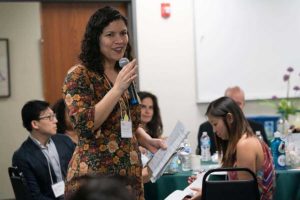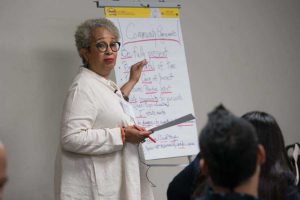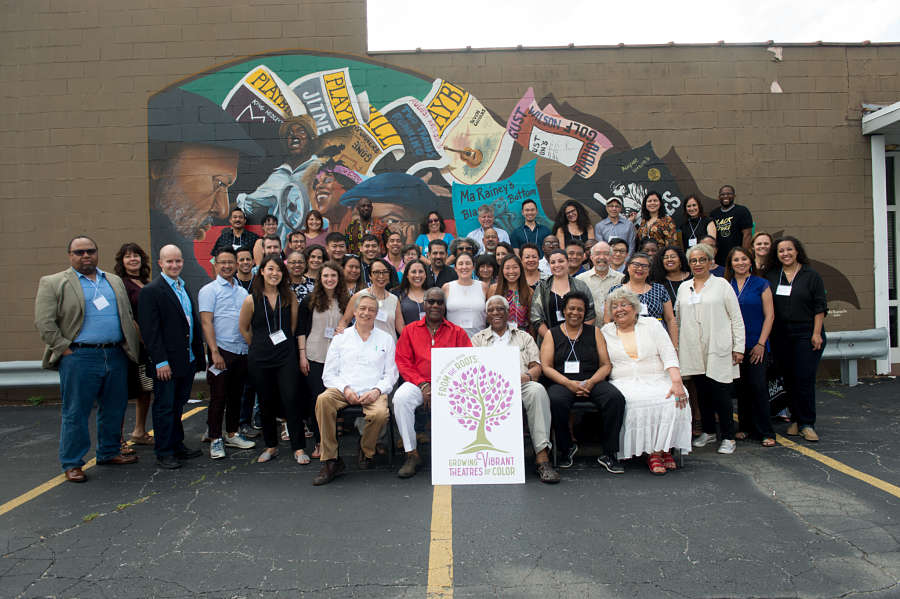ST. LOUIS: In 2001 Ron Himes reached out to the leadership of Theatre Communications Group and asked for their help in ensuring the survival of theaters of color. Himes founded the Black Rep, the largest professional African American theatre company in the nation, and the largest African American performing arts organization in Missouri. His phone call led to the very first theatres-of-color meeting in 2003. Representatives from 21 U.S. theatres of color met at White Oak Plantation in Yulee, Fla., for a historic sharing of challenges and practices. This year, with TCG’s annual conference in St. Louis, Himes invited TCG to the Black Rep for another check-in with theatres of color. And though many of the faces and names have changed since 2003, many of the challenges and practices facing theatres of color haven’t changed all that much.
“It was amazing to me that 15 years later we could be having this same conversation as back in 2003,” said Himes about Wednesday afternoon’s gathering, part of TCG’s pre-conference activities. “The difference today is that we will leave with marching orders—the first steps toward some solutions. So next time we have one of these meetings a lot of these issues will be off the table.”
When putting together the TOC meeting this time, the first thing TCG had to do was figure out how many theatres of color there are. TCG identified 165, but recognized that the actual number might be much higher; some companies might not be visible because they work in the margins. Out of the 165 companies identified, 85 invitations went out, and in attempt to creative the most diverse possible range of companies, Native American organizations were included (they had been overlooked at the first gathering). A total of 41 companies were able to send a representative, and a few independent artists were invited as well.
The afternoon was framed as a chance for theatres of color to discuss the problems they face and coming up with solutions. “We are observers here,” said Emilya Cachapero, director of artistic programs at TCG, which helped organize the gathering. “We’re not here to say, ‘This is what we think you should do.’ And maybe the solutions are not things TCG should do.”

Moderators Khanisha Foster, associate artistic director of 2nd Story, and Keryl McCord, president & CEO of Equity Quotient (EQ), had participants share personal moments when theatre really moved them. Then they were asked to distill what all these experiences had in common down into a few words. Ideas that showed up over and over included community, representation, and energy.
After looking at all these words McCord noted what wasn’t on the wall: grants. “There’s a disconnection between why we do theatre and how it gets done,” McCord said. “We need to talk about the 800-pound gorilla in the room: funding.”
McCord cited the report Not Just Money: Equity Issues in Cultural Philanthropy by Helicon Collaborative. The study found that in 2016 58 percent of all arts funding went to arts organizations with budgets of $5 million or more, even though these organizations make up only 2 percent of all arts and culture organizations. Additionally, only 4 percent of all arts funding is allocated to groups whose primary mission is to serve communities of color. “While these numbers tell us scarcity is real,” said Foster, “this space is the abundance.”
Foster opened up the discussion with the notion of cultural equity—the premise that all cultures have a right to thrive. “So how do we create a space where others thrive?” she wondered. She asked participants to name a roadblock to creating abundance for/with each other.

“And know that ‘money’ is off the table,” said McCord of the discussion. “We all know it’s an issue. But we don’t do theatre for grants. Liberation will not come from a grant.”
After identifiying those roadblocks, participants—divided into groups at their respective tables—worked together on ways to overcome them. Once each table came up with solutions to the identified problems, they selected three to share with the entire room. Then each group had to pick one and expand on it, coming up with actionable items that their groups could do to create abundance for other theaters of color. “Don’t worry if your group didn’t get your first choice for brainstorming solutions,” said Foster. “You can still work on those ideas on your own.”
What emerged from the various groups were six action steps:
- Open a call to a particular community, embracing intersectionality, for a collaborative storytelling project or story circle. Historically marginalized people would take the lead in a space of their own making.
- Organize another TOC meeting in NYC, convening for a pre-conference. Rotate meetings at theatre of colors all over the country.
- Create a culture of inclusion by sharing resources, including events, social media, and websites.
- Arrange a call/initiate contact with your local organizations of color. Let the ripple effect keep extending.
- Challenge organizations to create a mixed-race space of real conversations informed by the Mixed Race Bill of Rights with the clear end in mind that future audiences will be based on mixed racial identities.
- Identify affinity groups inside and outside your organizations.
Looking at that list, McCord said optimistically in closing, “If we can make even one of these happen, we’ll be in a better place than were we started today.”
And all the solutions presented throughout the afternoon came back to the ideas cited at the beginning, the words that described what energized everyone about theatre, and why they bother to do it at all: Community, representation, energy. All were in abundance at yesterday’s gathering, and at a lively party afterward at UrbArts. Here’s to them rippling out and infusing the national theatre scene of today and tomorrow.
TJ Acena is a writer based in Portland, Ore.


